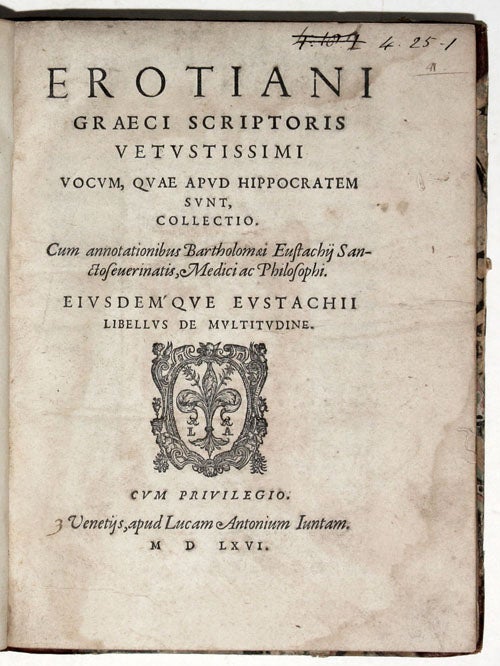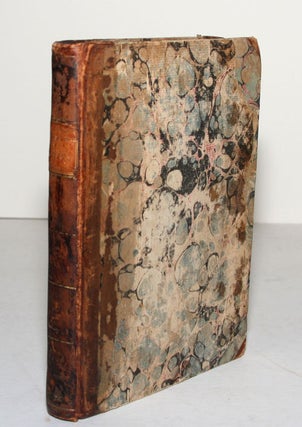Erotiani Graeci scriptoris vetustissimi vocum, apud Hippocratem sunt, collectio.
4to [20.3 x 15.6 cm], (10) ff., 152 ff., with woodcut device on title, woodcut headpieces, initials and tailpieces. Half bound in calf and marbled boards, gold-tooled title label laid to spine. Spine and boards rubbed and stained. Title page dusty and with ink shelf-mark, book label and release stamp of Trinity College Cambridge on verso of title, minor marginal worming in first ten leaves, pencil annotations to endpapers and occasionally in text, a few minor edge tears, moderate waterstaining throughout.
First edition of the renowned physician Bartolomeo Eustachi’s (c. 1500-1574) commentary on the Vocum of Erotianus (active c. 50-70 A.D.) an ancient collection of words found in the corpus of Hippocrates (c. 460-370 B.C.). A contemporary of Andreas Vesalius (1514-64), with whom he shares the distinction of having created the science of human anatomy, Eustachi was “perhaps the greatest anatomist of his time, and probably no other anatomist, ancient or modern, has made so many discoveries” (Thomas, p. 877). The work of Erotianus is notable for containing the earliest list of the writings of Hippocrates – which makes reference to several treatises now lost – and for providing ancient lexicographic information concerning not only the medical terminology of Hippocrates, but also many Greek usages found elsewhere in ancient prose and poetry of all sorts. Eustachi here brings to bear on Erotianus/Hippocrates the most up-to-date humanistic understanding of Greek grammar and medical practice, citing nearly 100 authors in his discussion of the more than 1200 terms chosen by Erotianus (all indexed in the front of the volume). Each entry consists of the Greek term from Hippocrates, the Latin gloss of Erotianus, and a longer annotatio by Eustachi.
Eustachi, born in San Severino, studied medicine in Rome and became a professor at the Sapienza by 1562. Although patronized by Cardinal Borromeo, he is said to have died in poverty. Eustachi greatly advanced the anatomical understanding of the ear (the Eustachian tube is named after him), is the first to have accurately described the anatomy of teeth, and was the first to discover the adrenal glands. His greatest work was to have been a book of engraved anatomical figures in the manner of Vesalius. Although finished in 1552, nine years after the great work of Vesalius appeared, the Tabulae anatomicae was not printed until 1714, thereafter becoming a bestseller in its several eighteenth-century editions.
The present volume, it should be noted, represents not only the first edition of Eustachi’s commentary, but also the first separate edition of Erotianus itself, postdating only the version contained in Henri Estienne’s (c. 1528-98) medical anthology, Dictionarium medicum (Geneva, Stephanus, 1564).
OCLC locates U.S. copies at UCLA, Northwestern, Illinois, National Library of Medicine, Washington University in Saint Louis, Yale Medical, Harvard, Dartmouth, and the Rochester Medical Center.
* Adams E927; L. Choulant, History and Bibliography of Anatomic Illustration (M. Mortimer trans.), pp. 200-4; Dizionario biografico degli italiani, vol. 43, pp. 531-6; J. Thomas, The Universal Dictionary of Biography, vol. 2, p. 877; K. B. Roberts, “Eustachius and His Anatomical Plates,” Newsletter for the Canadian Society for the History of Medicine (1979), April, pp. 9-13
Price: $2,850.00


